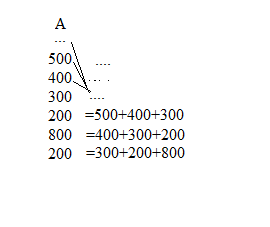- Home
- /
- Programming
- /
- SAS Procedures
- /
- How to sum across
- RSS Feed
- Mark Topic as New
- Mark Topic as Read
- Float this Topic for Current User
- Bookmark
- Subscribe
- Mute
- Printer Friendly Page
- Mark as New
- Bookmark
- Subscribe
- Mute
- RSS Feed
- Permalink
- Report Inappropriate Content
How i need to sum first column with another column across?
i mean this:
data stock;
input Astock Bstock;
cards;
500 250
200 658
300 425
400 125
;
run;
data sum;
set stock;
sum=sum(Astock,Bstock);
run;How i need to change it ?
Accepted Solutions
- Mark as New
- Bookmark
- Subscribe
- Mute
- RSS Feed
- Permalink
- Report Inappropriate Content
Like this?
data stock;
input Astock Bstock;
cards;
500 250
200 658
300 425
400 125
;
run;
data want;
set stock;
lag_Astock = lag1(Astock);
if not missing(lag_Astock) then total = sum(Bstock,lag_Astock);
drop lag_Astock;
run;- Mark as New
- Bookmark
- Subscribe
- Mute
- RSS Feed
- Permalink
- Report Inappropriate Content
Like this?
data stock;
input Astock Bstock;
cards;
500 250
200 658
300 425
400 125
;
run;
data want;
set stock;
lag_Astock = lag1(Astock);
if not missing(lag_Astock) then total = sum(Bstock,lag_Astock);
drop lag_Astock;
run;- Mark as New
- Bookmark
- Subscribe
- Mute
- RSS Feed
- Permalink
- Report Inappropriate Content
- Mark as New
- Bookmark
- Subscribe
- Mute
- RSS Feed
- Permalink
- Report Inappropriate Content
One more question :
If i have
And i need to find average of three variables and write to next, but first meaning is missing, so i don't need that;;
data numbers;
input A;
cards;
500
400
300
200
800
200
;
run;
data mean;
set numbers;
first = lag(A);
second=lag2(A);
third=lag3(A);
if _n_ ge 3 then mean= mean(of first,second,third);
final=lag1(mean);
run;but first of all it find mean of missing value+500+400/3=300
How to change ?
- Mark as New
- Bookmark
- Subscribe
- Mute
- RSS Feed
- Permalink
- Report Inappropriate Content
If you want a value to be counted in the denominator (3) then there must be a value in the numerator. which would have to be 0 if I understand what you are attempting if you want to use the MEAN function.
Or
mean = sum(of first,second,third) / 3;
When you start getting to complicated requirements to use values that are not in your data then you will have to provide the values using your business logic.
April 27 – 30 | Gaylord Texan | Grapevine, Texas
Registration is open
Walk in ready to learn. Walk out ready to deliver. This is the data and AI conference you can't afford to miss.
Register now and lock in 2025 pricing—just $495!
Learn the difference between classical and Bayesian statistical approaches and see a few PROC examples to perform Bayesian analysis in this video.
Find more tutorials on the SAS Users YouTube channel.
SAS Training: Just a Click Away
Ready to level-up your skills? Choose your own adventure.





